I have a UIView that I want to mask with another UIView, punching a hole out of its center. Here's my viewDidLoad:
- (void)viewDidLoad {
[super viewDidLoad];
[self.view addSubview:self.viewToMask];
[self.view addSubview:self.theMask];
[self.view addConstraint:[NSLayoutConstraint constraintWithItem:self.viewToMask attribute:NSLayoutAttributeCenterX relatedBy:NSLayoutRelationEqual toItem:self.view attribute:NSLayoutAttributeCenterX multiplier:1.0 constant:0.0]];
[self.view addConstraint:[NSLayoutConstraint constraintWithItem:self.viewToMask attribute:NSLayoutAttributeCenterY relatedBy:NSLayoutRelationEqual toItem:self.view attribute:NSLayoutAttributeCenterY multiplier:1.0 constant:0.0]];
[self.view addConstraints:[NSLayoutConstraint constraintsWithVisualFormat:@"[cyan(200)]" options:0 metrics:nil views:@{@"cyan": self.viewToMask}]];
[self.view addConstraints:[NSLayoutConstraint constraintsWithVisualFormat:@"V:[cyan(200)]" options:0 metrics:nil views:@{@"cyan": self.viewToMask}]];
[self.view addConstraint:[NSLayoutConstraint constraintWithItem:self.theMask attribute:NSLayoutAttributeCenterX relatedBy:NSLayoutRelationEqual toItem:self.viewToMask attribute:NSLayoutAttributeCenterX multiplier:1.0 constant:0.0]];
[self.view addConstraint:[NSLayoutConstraint constraintWithItem:self.theMask attribute:NSLayoutAttributeCenterY relatedBy:NSLayoutRelationEqual toItem:self.viewToMask attribute:NSLayoutAttributeCenterY multiplier:1.0 constant:0.0]];
[self.view addConstraints:[NSLayoutConstraint constraintsWithVisualFormat:@"[mask(100)]" options:0 metrics:nil views:@{@"mask": self.theMask}]];
[self.view addConstraints:[NSLayoutConstraint constraintsWithVisualFormat:@"V:[mask(100)]" options:0 metrics:nil views:@{@"mask": self.theMask}]];
}
It gives me exactly what I'm looking for, minus the masking:

If I add one more line:
[self.viewToMask setMaskView:self.theMask];
both views disappear --- the small view (self.theMask) masks out the whole larger view (self.viewToMask) even though it's only half the size. Does anyone understand what's going on here? Can you not use UIView.maskView with Auto Layout?
